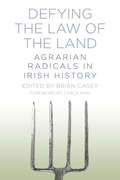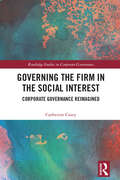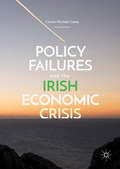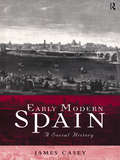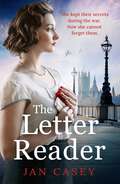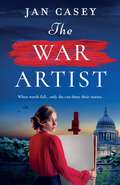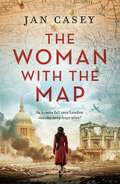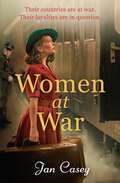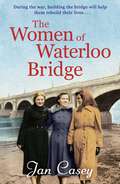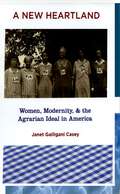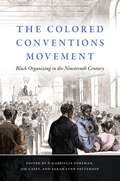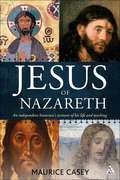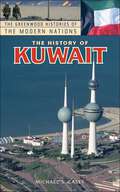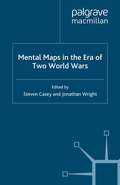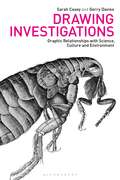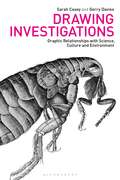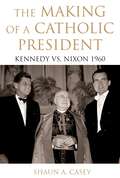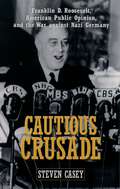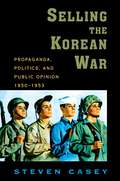- Table View
- List View
Defying the Law of the Land: Agrarian Radicals in Irish History
by Brian CaseyThis history of Ireland is inextricably linked with our relationship with the land. In this book, based on extensive research and investigation, the authors examine some of the key figures in Irish agrarian agitation and change. Looking at the Land League, the Knights of the Plough, the perception and reality of the Irish Landlords, this is an important book which makes a significant contribution to our understanding of the nature of the ‘land question’ in Irish history.
Governing the Firm in the Social Interest: Corporate Governance Reimagined (Routledge Studies in Corporate Governance)
by Catherine CaseyThe corporate business enterprise is a core institution of capitalism. It holds immense political, economic, and cultural power in society. It mobilizes social and planetary resources to its utility in pursuit of private profit maximization and with little regard for social concerns. Its influence over so much of societal life and effects on the natural environment raise critical questions about the firm and its governance in democratic society. Various voices seek reforms of regulation and corporate governance practices to those shaped by the neoliberal policies persisting in the current decades. But prospects for amelioration within our current horizons of thinking appear elusive. This book contributes a distinctly social theoretical approach to the social problem of governing the firm. Its discussions complement debates in economics, politics, and law. Its critical social theorizations challenge conventional understandings of the firm and neoliberal legitimacies of its governance and posit alternatives. The book explores the social relations and moral fabric of the firm and the creativity of human action at work. It proposes a reimagined corporate governance premised on just recognition of that social vitality. It invites unprecedented collaboration for a robust participatory democracy for governing the firm and market action oriented to ecological and social sustainability.
Governing the Firm in the Social Interest: Corporate Governance Reimagined (Routledge Studies in Corporate Governance)
by Catherine CaseyThe corporate business enterprise is a core institution of capitalism. It holds immense political, economic, and cultural power in society. It mobilizes social and planetary resources to its utility in pursuit of private profit maximization and with little regard for social concerns. Its influence over so much of societal life and effects on the natural environment raise critical questions about the firm and its governance in democratic society. Various voices seek reforms of regulation and corporate governance practices to those shaped by the neoliberal policies persisting in the current decades. But prospects for amelioration within our current horizons of thinking appear elusive. This book contributes a distinctly social theoretical approach to the social problem of governing the firm. Its discussions complement debates in economics, politics, and law. Its critical social theorizations challenge conventional understandings of the firm and neoliberal legitimacies of its governance and posit alternatives. The book explores the social relations and moral fabric of the firm and the creativity of human action at work. It proposes a reimagined corporate governance premised on just recognition of that social vitality. It invites unprecedented collaboration for a robust participatory democracy for governing the firm and market action oriented to ecological and social sustainability.
Policy Failures and the Irish Economic Crisis
by Ciarán Michael CaseyThis book seeks to understand why almost all commentators on the Irish economy were unprepared for the scale of the recent economic crisis. It analyses the public contributions from a broad range of observers, including domestic and international agencies, academics, the newspapers and politicians. This approach gives new insights into the analytical and institutional shortfalls that inhibited observers from recognising the degree of the risk. The book demonstrates that most commentators were either impeded in what they could say, or else lacked the expertise to challenge the prevailing view. The findings have significant implications for a broad range of institutions, particularly the media and the Oireachtas (the Irish Parliament).
Policy Failures and the Irish Economic Crisis (PDF)
by Ciarán Michael CaseyThis book seeks to understand why almost all commentators on the Irish economy were unprepared for the scale of the recent economic crisis. It analyses the public contributions from a broad range of observers, including domestic and international agencies, academics, the newspapers and politicians. This approach gives new insights into the analytical and institutional shortfalls that inhibited observers from recognising the degree of the risk. The book demonstrates that most commentators were either impeded in what they could say, or else lacked the expertise to challenge the prevailing view. The findings have significant implications for a broad range of institutions, particularly the media and the Oireachtas (the Irish Parliament).
Early Modern Spain: A Social History (Social History Of Europe Ser.)
by James CaseyEarly Modern Spain: A social History explores the solidarities which held the Spanish nation together at this time of conflict and change. The book studies the pattern of fellowship and patronage at the local level which contributed to the notable absence of popular revolts characteristic of other European countries at this time. It also analyses the Counter-Reformation, which transformed religious attitudes, and which had a huge impact on family life, social control and popular culture.Focusing on the main themes of the development of capitalism, the growth of the state and religious upheaval, this comprehensive social history sheds light on changes throughout Europe in the critical early modern period.
Early Modern Spain: A Social History
by James CaseyEarly Modern Spain: A social History explores the solidarities which held the Spanish nation together at this time of conflict and change. The book studies the pattern of fellowship and patronage at the local level which contributed to the notable absence of popular revolts characteristic of other European countries at this time. It also analyses the Counter-Reformation, which transformed religious attitudes, and which had a huge impact on family life, social control and popular culture.Focusing on the main themes of the development of capitalism, the growth of the state and religious upheaval, this comprehensive social history sheds light on changes throughout Europe in the critical early modern period.
The Letter Reader
by Jan CaseyShe read their secrets during the war. Now she cannot forget them...1941. London. Keen to do her bit in the war, Connie Allinson joins the WRNS and is posted as a letter censor. Her task: to read and alter correspondence to ensure no sensitive information crosses enemy lines. At first, she is not sure she's up to it, but is soon drawn in by the letters she reads, and their secrets...1967. Doncaster. Bored of her domestic life, Connie desperately wants a job, but her controlling husband Arthur won't hear of it. Looking for an escape, and plagued by memories of letters she read during the war, she makes a bid for freedom and starts secretly tracking down their authors. Will uncovering their past give Connie the key to her present? And will she be able to find them all before Arthur discovers what she is keeping from him?A page-turning and evocative historical timeslip, for fans of Mandy Robothom and Melanie Hudson.
The War Artist: Brand-new for 2024, the next captivating, historical novel from Jan Casey about a female war artist in World War 2.
by Jan Casey'Excellent! Jan has written a memorable story about a war time artist that's so descriptive you are completely immersed in it. I thoroughly enjoyed it. Sybil is an extraordinary woman taking on this...' - NetGalley reviewer, 5****'Excuse me,' the man interrupted her as if there was absolutely nothing she could say to comfort him. 'I have to get on with my digging.' Then he stabbed violently at her sketchbook with his finger. 'Get it all down,' he snarled. 'Every single disgusting, pathetic detail. And shove it in their faces.'London, 1940Following a chance meeting with her former teacher, young painter Sybil Paige wins a coveted assignment from the War Artists' Advisory Committee, and so begins her journey across the length and breadth of the country, sketching everything from airfields and assembly lines to farms and factories.Sometimes it's milkmaids and poultry keepers, brave and hopeful; sometimes it's the harrowed faces of those digging through the rubble to find their loved ones and livelihoods. But armed with her sketchbook, Sybil captures it all, determined to tell the stories of the thousands of women fighting their own battles on the home front. Above all, she wants the voices of her subjects to shine through.But amidst the scenes of despair and courage, the one picture Sybil cannot paint and yet cannot purge from her brain, no matter how hard she tries, is the image of a woman folded into a chair, the crumpled telegram about her missing husband clasped in her hand. Because a self-portrait, Sybil well knows, requires the artist to find her own voice.With each new commission, Sybil grows in confidence. But, like the many people she meets and sketches, she fears the future: will it bring hope or heartbreak?***Readers love Jan Cacey:'[A] captivating, heart wrenching saga... I adamantly recommend' - 5* reader review'A story of courage and hope' - 5* reader review'I love this book... This book drew me in straight away and I just wanted to keep on reading until I finished it. A lovely story' - 5* reader review'Poignant, warm, gut wrenching and hopeful, this book is just beautiful. I stayed riveted the entire time and could not put it down' - 5* reader review'The book is full of fervor and the characters grow from beginning to end! I could not put the book down!' - 5* reader review
The Woman with the Map
by Jan CaseyFebruary 1941 The world is at war and Joyce Cooper is doing her bit for the war effort. A proud member of the Civil Defence, it is her job to assist the people of Notting Hill when the bombs begin to fall. But as the Blitz takes hold of London, Joyce is called upon to plot the devastation that follows in its wake. Night after night she must stand before her map and mark the trail of loss and suffering inflicted upon the homes, families and businesses she knows so well.February 1974 Decades later from her basement flat Joyce watches the world go by above her head. This is her haven; the home she has created for herself having had so much taken from her in the war. But now the council is tearing down her block of flats and she's being forced to move. Could this chance to start over allow Joyce to let go of the past and step back into her life?An emotional and compelling historical fiction novel perfect for fans of Fiona Valpy, Mandy Robotham and Catherine Hokin.Readers love Jan Casey: 'Captivating, heart-wrenching'saga... I adamantly recommend' NetGalley Reviewer, ?????'A story of courage and hope' NetGalley Reviewer, ?????'Drew me in straight away and I just wanted to keep on reading until I finished it' NetGalley Reviewer, ?????'Gut-wrenching and hopeful, this book is just beautiful. I stayed riveted the entire time and could not put it down' Goodreads Reviewer, ?????'Full of fervour and the characters grow from beginning to end! I could not put the book down!' NetGalley Reviewer, ?????'A book that you won't want to put down. I loved all the characters and where this book took me. A lovely read' NetGalley Reviewer, ?????'Was desperate to see how it panned out... Very interesting reading it from both sides rather than just your own country. Recommend it' NetGalley Reviewer, ?????
Women at War
by Jan CaseyTwo women. One war. For Viola Baxter, 1939 was supposed to be a wonderful year. After meeting and falling in love with dashing Fred Scholz at Cambridge University, they planned to marry and start their new lives together. She never imagined her father would say no to the marriage. Fred is half-German and, with war fast approaching, he must travel to Germany to bring his sister home. But that journey is enough for others to suspect him... and Viola.When Annie Scholz heard her beloved grandmother was seriously ill, she wasted no time rushing to Germany to be by her side. She didn't realise it meant she would not be able to return home to the UK, or that her decision would endanger her brother, Fred, as well. Even reuniting with her childhood beau is bittersweet – how can she love someone who stands for everything she opposes? With everyone watching Annie and Fred so closely, there is no room for error... or dangerous resistance.With war the only certainty, there's just one thing in question: where do Viola and Annie's loyalties lie? Women at War is the thrilling and heart-wrenching new WW2 story from Jan Casey, author of The Women of Waterloo Bridge. What readers are saying about Women at War: '[A] captivating, heart wrenching saga... I adamantly recommend' - 5* reader review'A story of courage and hope' - 5* reader review'I love this book... This book drew me in straight away and I just wanted to keep on reading until I finished it. A lovely story' - 5* reader review'Poignant, warm, gut wrenching and hopeful, this book is just beautiful. I stayed riveted the entire time and could not put it down' - 5* reader review'The book is full of fervor and the characters grow from beginning to end! I could not put the book down!' - 5* reader review
The Women of Waterloo Bridge: the heart-wrenching WW2 saga of 2020
by Jan CaseyLondon, 1940. After her fiancé breaks off their engagement, Evelyn decides to do her part for the war effort by signing up for construction work on Waterloo Bridge. Enjoying the physical work and her newfound purpose, she begins to realise that there could be so much more to her life than anything she'd ever dared to dream of. Grieving after her little boy dies in an air raid, Gwen is completely lost when her husband sends their younger children to the countryside for safety. Enlisting as a construction worker, she is partnered with cheerful Evelyn. Despite Gwen's initial reticence, the two women strike up a heartwarming friendship – but will it be enough to save Gwen from her sorrow? Musical prodigy Joan's life has always been dictated by her controlling mother. When an affair nearly ends in scandal, Joan finally takes her life into her own hands. Determined never to touch a violin again, she soon finds work at Waterloo Bridge. Yet there are other troubles for her to overcome... For these three women, only one thing is certain: the Second World War will change their lives forever. A heart-wrenching new WW2 saga for fans of Jenny Holmes and Soraya M. Lane.
A New Heartland: Women, Modernity, and the Agrarian Ideal in America
by Janet Galligani CaseyModernity and urbanity have long been considered mutually sustaining forces in early twentieth-century America. But has the dominance of the urban imaginary obscured the importance of the rural? How have women, in particular, appropriated discourses and images of rurality to interrogate the problems of modernity? And how have they imbued the rural-traditionally viewed as a locus for conservatism-with a progressive political valence? Touching on such diverse subjects as eugenics, reproductive rights, advertising, the economy of literary prizes, and the role of the camera, A New Heartland demonstrates the importance of rurality to the imaginative construction of modernism/modernity; it also asserts that women, as objects of scrutiny as well as agents of critique, had a special stake in that relation. Casey traces the ideals informing America's conception of the rural across a wide field of representational domains, including social theory, periodical literature, cultural criticism, photography, and, most especially, women's rural fiction ("low" as well as "high"). Her argument is informed by archival research, most crucially through a careful analysis of The Farmer's Wife, the single nationally distributed farm journal for women and a little known repository of rural American attitudes. Through this broad scope, A New Heartland articulates an alternative mode of modernism by challenging orthodox ideas about gender and geography in twentieth-century America.
The Colored Conventions Movement: Black Organizing in the Nineteenth Century (The John Hope Franklin Series in African American History and Culture)
by Jim Casey P. Gabrielle Foreman Sarah Lynn PattersonThis volume of essays is the first to focus on the Colored Conventions movement, the nineteenth century's longest campaign for Black civil rights. Well before the founding of the NAACP and other twentieth-century pillars of the civil rights movement, tens of thousands of Black leaders organized state and national conventions across North America. Over seven decades, they advocated for social justice and against slavery, protesting state-sanctioned and mob violence while demanding voting, legal, labor, and educational rights. While Black-led activism in this era is often overshadowed by the attention paid to the abolition movement, this collection centers Black activist networks, influence, and institution building. Collectively, these essays highlight the vital role of the Colored Conventions in the lives of thousands of early organizers, including many of the most famous writers, ministers, politicians, and entrepreneurs in the long history of Black activism.Contributors: Erica L. Ball, Kabria Baumgartner, Daina Ramey Berry, Joan L. Bryant, Jim Casey, Benjamin Fagan, P. Gabrielle Foreman, Eric Gardner, Andre E. Johnson, Cheryl Janifer LaRoche, Sarah Lynn Patterson, Carla L. Peterson, Jean Pfaelzer, Selena R. Sanderfer, Derrick R. Spires, Jermaine Thibodeaux, Psyche Williams-Forson, and Jewon Woo.Explore accompanying exhibits and historical records at The Colored Conventions Project website: https://coloredconventions.org/
Jesus of Nazareth: An independent historian's account of his life and teaching
by Maurice CaseyA new 'life' of Jesus written by one of the outstanding scholars of his generation, it offers a complete resource on the 'Historical Jesus' debate. With an overview of the various positions taken on who the historical Jesus was, Casey provides a helpful and accessible tool for understanding how the historical Jesus has been received and understood, with attention paid to the contortions in evidence in the last century to prove that Jesus was not Jewish.
The History of Kuwait (The Greenwood Histories of the Modern Nations)
by Michael S. CaseyThe tiny country of Kuwait grabbed the world's attention during the Gulf War, during which its natural petroleum resource became the envy of its neighboring country of Iraq. But Kuwait's history goes back long before any oil was discovered, back to Mesopotamian settlements as early as 3000 BCE. Ideal for high school students as well as general readers, History of Kuwait offers a comprehensive look at how such a small country could, essentially, rule the world with just one natural resource. From sheikhdom to British protectorate to independence to invasion, Kuwait's history is long and rich with culture. Michael S. Casey demonstrates how this Middle Eastern gem has grown throughout the centuries.
Mental Maps in the Era of Two World Wars
by S. Casey J. WrightThis book explores the 'mental maps' of leading political figures of the era of two world wars. Chapters focus on those giants whose ideas cast a compelling shadow: Lloyd George, Lenin, Mussolini, Hitler, Roosevelt, Churchill, Briand and Stresemann, as well as other important figures: Poincaré, Atatuerk, Beneš, Chiang and Mao.
Drawing Investigations: Graphic Relationships with Science, Culture and Environment (Drawing In)
by Sarah Casey Gerry DaviesUsing close visual analysis of drawings, artist interviews, critical analysis and exegesis, Drawing Investigations examines how artists use drawing as an investigative tool to reveal information that would otherwise remain unseen and unnoticed.How does drawing add shape to ideas? How does the artist accommodate to challenges and restraints of a particular environment? To what extent is a drawing complementary and continuous with its subject and where is it disruptive and provocative? Casey and Davies address these questions while focusing on artists working collaboratively and the use of drawing in challenging or unexpected environments. Drawing Investigations evaluates the emergence of a way of thinking among an otherwise disconnected group of artists by exploring commonalities in the application of analytical drawing to the natural world, urban environment, social forces and lived experience. Examples represent a spectrum of research in international contexts: an oceanographic Institute in California, the archives of Amsterdam's Rijksmuseum, the Antarctic Survey, geothermal research in Japan and the Kurdish diaspora in Iraq. Issues are situated in the contemporary theory and practice of drawing including relationships to historical precedents.By exploring drawing's capacity to capture and describe experience, to sharpen visual faculties and to bridge embodied and conceptual knowledge, Drawing Investigations offers a fresh critical perspective on contemporary drawing practice.
Drawing Investigations: Graphic Relationships with Science, Culture and Environment (Drawing In)
by Sarah Casey Gerry DaviesUsing close visual analysis of drawings, artist interviews, critical analysis and exegesis, Drawing Investigations examines how artists use drawing as an investigative tool to reveal information that would otherwise remain unseen and unnoticed.How does drawing add shape to ideas? How does the artist accommodate to challenges and restraints of a particular environment? To what extent is a drawing complementary and continuous with its subject and where is it disruptive and provocative? Casey and Davies address these questions while focusing on artists working collaboratively and the use of drawing in challenging or unexpected environments. Drawing Investigations evaluates the emergence of a way of thinking among an otherwise disconnected group of artists by exploring commonalities in the application of analytical drawing to the natural world, urban environment, social forces and lived experience. Examples represent a spectrum of research in international contexts: an oceanographic Institute in California, the archives of Amsterdam's Rijksmuseum, the Antarctic Survey, geothermal research in Japan and the Kurdish diaspora in Iraq. Issues are situated in the contemporary theory and practice of drawing including relationships to historical precedents.By exploring drawing's capacity to capture and describe experience, to sharpen visual faculties and to bridge embodied and conceptual knowledge, Drawing Investigations offers a fresh critical perspective on contemporary drawing practice.
The Making of a Catholic President: Kennedy vs. Nixon 1960
by Shaun CaseyThe 1960 presidential election, won ultimately by John F. Kennedy, was one of the closest and most contentious in American history. The country had never elected a Roman Catholic president, and the last time a Catholic had been nominated--New York Governor Al Smith in 1928--he was routed in the general election. From the outset, Kennedy saw the religion issue as the single most important obstacle on his road to the White House. He was acutely aware of, and deeply frustrated by, the possibility that his personal religious beliefs could keep him out of the White House. In The Making of a Catholic President, Shaun Casey tells the fascinating story of how the Kennedy campaign transformed the "religion question" from a liability into an asset, making him the first (and still only) Catholic president. Drawing on extensive archival research, including many never-before-seen documents, Casey takes us inside the campaign to show Kennedy's chief advisors--Ted Sorensen, John Kenneth Galbraith, Archibald Cox--grappling with the staunch opposition to the candidate's Catholicism. Casey also reveals, for the first time, many of the Nixon campaign's efforts to tap in to anti-Catholic sentiment, with the aid of Billy Graham and the National Association of Evangelicals, among others. The alliance between conservative Protestants and the Nixon campaign, he shows, laid the groundwork for the rise of the Religious Right. This book will shed light on one of the most talked-about elections in American history, as well as on the vexed relationship between religion and politics more generally. With clear relevance to our own political situation--where politicians' religious beliefs seem more important and more volatile than ever--The Making of a Catholic President offers rare insights into one of the most extraordinary presidential campaigns in American history.
The Making of a Catholic President: Kennedy vs. Nixon 1960
by Shaun CaseyThe 1960 presidential election, won ultimately by John F. Kennedy, was one of the closest and most contentious in American history. The country had never elected a Roman Catholic president, and the last time a Catholic had been nominated--New York Governor Al Smith in 1928--he was routed in the general election. From the outset, Kennedy saw the religion issue as the single most important obstacle on his road to the White House. He was acutely aware of, and deeply frustrated by, the possibility that his personal religious beliefs could keep him out of the White House. In The Making of a Catholic President, Shaun Casey tells the fascinating story of how the Kennedy campaign transformed the "religion question" from a liability into an asset, making him the first (and still only) Catholic president. Drawing on extensive archival research, including many never-before-seen documents, Casey takes us inside the campaign to show Kennedy's chief advisors--Ted Sorensen, John Kenneth Galbraith, Archibald Cox--grappling with the staunch opposition to the candidate's Catholicism. Casey also reveals, for the first time, many of the Nixon campaign's efforts to tap in to anti-Catholic sentiment, with the aid of Billy Graham and the National Association of Evangelicals, among others. The alliance between conservative Protestants and the Nixon campaign, he shows, laid the groundwork for the rise of the Religious Right. This book will shed light on one of the most talked-about elections in American history, as well as on the vexed relationship between religion and politics more generally. With clear relevance to our own political situation--where politicians' religious beliefs seem more important and more volatile than ever--The Making of a Catholic President offers rare insights into one of the most extraordinary presidential campaigns in American history.
Cautious Crusade: Franklin D. Roosevelt, American Public Opinion, and the War against Nazi Germany
by Steven CaseyAmerica's struggle against Nazism is one of the few aspects of World War II that has escaped controversy. Historians agree that it was a widely popular war, different from the subsequent conflicts in Korea and Vietnam because of the absence of partisan sniping, ebbing morale, or calls for a negotiated peace. In this provocative book, Steven Casey challenges conventional wisdom about America's participation in World War II. Drawing on the numerous opinion polls and surveys conducted by the U.S. government, he traces the development of elite and mass attitudes toward Germany, from the early days of the war up to its conclusion. Casey persuasively argues that the president and the public rarely saw eye to eye on the nature of the enemy, the threat it posed, or the best methods for countering it. He describes the extensive propaganda campaign that Roosevelt designed to build support for the war effort, and shows that Roosevelt had to take public opinion into account when formulating a host of policies, from the Allied bombing campaign to the Morgenthau plan to pastoralize the Third Reich. By examining the previously unrecognized relationship between public opinion and policy making during World War II, Casey's groundbreaking book sheds new light on a crucial era in American history.
Cautious Crusade: Franklin D. Roosevelt, American Public Opinion, and the War against Nazi Germany
by Steven CaseyAmerica's struggle against Nazism is one of the few aspects of World War II that has escaped controversy. Historians agree that it was a widely popular war, different from the subsequent conflicts in Korea and Vietnam because of the absence of partisan sniping, ebbing morale, or calls for a negotiated peace. In this provocative book, Steven Casey challenges conventional wisdom about America's participation in World War II. Drawing on the numerous opinion polls and surveys conducted by the U.S. government, he traces the development of elite and mass attitudes toward Germany, from the early days of the war up to its conclusion. Casey persuasively argues that the president and the public rarely saw eye to eye on the nature of the enemy, the threat it posed, or the best methods for countering it. He describes the extensive propaganda campaign that Roosevelt designed to build support for the war effort, and shows that Roosevelt had to take public opinion into account when formulating a host of policies, from the Allied bombing campaign to the Morgenthau plan to pastoralize the Third Reich. By examining the previously unrecognized relationship between public opinion and policy making during World War II, Casey's groundbreaking book sheds new light on a crucial era in American history.
Selling the Korean War: Propaganda, Politics, and Public Opinion in the United States, 1950-1953
by Steven CaseyHow presidents spark and sustain support for wars remains an enduring and significant problem. Korea was the first limited war the U.S. experienced in the contemporary period - the first recent war fought for something less than total victory. In Selling the Korean War , Steven Casey explores how President Truman and then Eisenhower tried to sell it to the American public. Based on a massive array of primary sources, Casey subtly explores the government's selling activities from all angles. He looks at the halting and sometimes chaotic efforts of Harry Truman and Dean Acheson, Dwight Eisenhower and John Foster Dulles. He examines the relationships that they and their subordinates developed with a host of other institutions, from Congress and the press to Hollywood and labor. And he assesses the complex and fraught interactions between the military and war correspondents in the battlefield theater itself. From high politics to bitter media spats, Casey guides the reader through the domestic debates of this messy, costly war. He highlights the actions and calculations of colorful figures, including Senators Robert Taft and JHoseph McCarthy, and General Douglas MacArthur. He details how the culture and work routines of Congress and the media influenced political tactics and daily news stories. And he explores how different phases of the war threw up different problems - from the initial disasters in the summer of 1950 to the giddy prospects of victory in October 1950, from the massive defeats in the wake of China's massive intervention to the lengthy period of stalemate fighting in 1952 and 1953.
Selling the Korean War: Propaganda, Politics, and Public Opinion in the United States, 1950-1953
by Steven CaseyHow presidents spark and sustain support for wars remains an enduring and significant problem. Korea was the first limited war the U.S. experienced in the contemporary period - the first recent war fought for something less than total victory. In Selling the Korean War , Steven Casey explores how President Truman and then Eisenhower tried to sell it to the American public. Based on a massive array of primary sources, Casey subtly explores the government's selling activities from all angles. He looks at the halting and sometimes chaotic efforts of Harry Truman and Dean Acheson, Dwight Eisenhower and John Foster Dulles. He examines the relationships that they and their subordinates developed with a host of other institutions, from Congress and the press to Hollywood and labor. And he assesses the complex and fraught interactions between the military and war correspondents in the battlefield theater itself. From high politics to bitter media spats, Casey guides the reader through the domestic debates of this messy, costly war. He highlights the actions and calculations of colorful figures, including Senators Robert Taft and JHoseph McCarthy, and General Douglas MacArthur. He details how the culture and work routines of Congress and the media influenced political tactics and daily news stories. And he explores how different phases of the war threw up different problems - from the initial disasters in the summer of 1950 to the giddy prospects of victory in October 1950, from the massive defeats in the wake of China's massive intervention to the lengthy period of stalemate fighting in 1952 and 1953.
